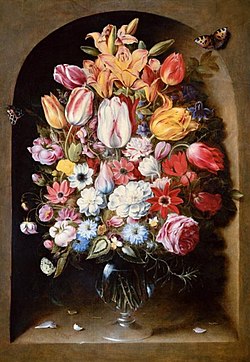奥夏斯.贝尔Osias Beert
奥夏斯.贝尔Osias Beert(1580年—1624年),佛兰德画家。他被公认为最具影响力的艺术家之一。是佛兰德最早的一代的静物画家。
中国美术网 09-18 浏览
生活
篮子里的花
对这个艺术家的早期生活。据说他出生在安特卫普约1580,研究下鲜为人知的安德利van Baesrode(或“van Baseroo”)。他加入了这个城市的圣卢克的公会在1602年和1606年1月8日玛格丽特Ykens结婚。
Beert不仅是画家,也作为一个软木商人交易。[2]Beert也是成员之一的地方钱伯斯的言辞,这表明他参与绘画以外的知识的追求。[1]据信,他是死于安特卫普在1623年底或1624年。
他的学生包括弗兰斯范德Borch,Frans Ykens(谁是他的侄子),保卢斯本丢和1月Willemsen。Beert的儿子,Osias Beert年轻(1622 - 78),也是一个画家,但不太可能过他的父亲自从他父亲被认为是在儿子很小的时候去世了。
工作
束在一个利基
Osias Beert主要是被称为一个画家的鲜花和宴会(早餐)作品,流派,他发挥了先锋作用。他很少签名或者字母组合,永不过时的他的工作。他的作品对铜三熊面板制造商Pieter斯塔斯和马克的日期1607年,1608年和1609年。尽管缺乏过时的工作使得它难以日期他的作品,风格分析允许一个试探性的年表。与高角度和小重叠的对象被认为是比那些较低的观点和夯实安排的对象。这些后来的作品也有一个更好的空间相干性。
只有四个签名的作品他从这些有可能是已知的和工作的四个属性格勒诺布尔博物馆给他。因为知识这个早期阶段的佛兰德静物还是断断续续的有倾向Beert属性太多的工作。有些作品归因于他可能是由他的学生,虽然有些归因于Osias Beert年轻的可能是他父亲画的。
Osias Beert经常画在橡木板,使用玻璃技术。通过使用多个叠加层的液体油他能够获得一个透明和各种各样的颜色。他的一些作品是铜。
静物和三个酒杯在一个利基
他是第一个艺术家专注于静物画的生产这种类型的作品仍小,通常是匿名的。他的早餐,通常被称为荷兰名字ontbijtjes(“小早餐”),代表现场强迫透从高的角度。
这种技术通常月初弗兰德和荷兰的静物画。他的作品经常显示密度分组在一个平衡的安排。他的风格是quasi-geometric并显示细节的眼睛。
他努力客观并显示强烈的可塑性。他的静物画都沐浴在一个甚至和漫射光。一个例子是仍然生活在中国碗樱桃和草莓 (Gemaldegalerie,柏林),它显示了一个宴会的表上略有倾斜,这样的对象可以没有阻碍。这幅画代表了8 - 9课的最后一道菜宴会。蜻蜓和蝴蝶有象征意义和代表善与恶之间的斗争。
早餐静物
他他的画作的牡蛎和糖果一起商品陈列有序的桌面宝贵的酒杯和中国瓷器。他的能力是无与伦比的描绘与光在粘性和珍珠牡蛎肉和湿润区分的牡蛎壳坚硬表面的内部。一个很好的例子就是静物与牡蛎(国家美术馆的艺术华盛顿)显示,牡蛎在盘子里一起珍贵的对在一个表扩展双方以外的帆布在一个黑暗的背景下。
他的静物画花,经常显示一个花瓶的花浅利基或一篮子充满鲜花,花篮,是可见的美术博物馆,休斯顿让人想起的作品吗Ambrosius Bosschaert.在显示他的花片每一朵花绽放的峰值和详细。花中描述相同的气味经常在不同季节盛开,永远不可能在现实中已经显示在相同的花瓶。因此他们象征着人的现世存在的短暂。一个例子是一个利基的花束Rockox房子,安特卫普。
Life
Little is known about this artist's early life. It is believed that he was born in Antwerp around 1580 and studied under the little-known Andries van Baesrode (or 'van Baseroo'). He joined the city's Guild of St. Luke in 1602 and married Marguerite Ykens on 8 January 1606.
Beert was not only a painter but also traded as a cork merchant.[2] Beert was also a member of one of the local Chambers of rhetoric, which suggests he was involved in intellectual pursuits other than painting.He is believed to have died in Antwerp at the end of 1623 or 1624.
His pupils included Frans van der Borch, Frans Ykens (who was his nephew),Paulus Pontius and Jan Willemsen. Beert’s son, Osias Beert the Younger (1622–78), was also a painter but is unlikely to have studied under his father since his father is believed to have died when the son was very young.
Work
Osias Beert is mainly known as a painter of flowers and banquet (breakfast) pieces, genres in which he played a pioneering role. He rarely signed or monogrammed and never dated his work. Of his works created on copper three bear the mark of the panel maker Pieter Stas and the dates 1607, 1608 and 1609. Even while a lack of dated works has made it difficult to date his work, stylistic analysis allows a tentative chronology. The works with a high viewpoint and little overlapping of objects are regarded as earlier than those with a lower viewpoint and a compacter arrangement of objects. These later works also have a better spatial coherence.
Only four signed works by him are known and from these it has been possible to attribute four works in the Museum of Grenoble to him. Since knowledge about this early stage of the Flemish still life is still fragmentary there has been a tendency to attribute too many works to Beert. Some works attributed to him are likely by his pupils, while some attributed to Osias Beert the younger were probably painted by his father.
Osias Beert often painted on oak panels, using a glazing technique. By using multiple superimposed layers of very fluid oil he was able to obtain a transparency and a wide variety of colours.[5] Some of his works are on copper.
He was one of the first artists to specialize in still life painting when the production of works in this genre was still minor and typically anonymous. His breakfast pieces, usually referred to by their Dutch name ontbijtjes ("little breakfasts"), represent the scene from a high viewpoint with a forced perspective.
This technique is commonly seen in early Flemish and Dutch still life painting. His compositions often show dense groupings in a balanced arrangement. His style is quasi-geometric and shows an eye for detail.
He strived for objectivity and displayed a strong sense of plasticity. His still lifes are bathed in an even and diffused light An example is Still life with cherries and strawberries in China bowls (Gemäldegalerie, Berlin), which shows a banquet piece on a table that is slightly tilted so that the objects on it can be viewed without obstruction. The painting represents the last course of an eight to nine course banquet. The dragonfly and the butterfly have an emblematic meaning and represent the fight between good and evil.
He was known for his paintings of oysters and confectionery goods displayed orderly on tabletops together with precious wine glasses and Chinese porcelain.He was unmatched in his ability to depict oysters with light playing on the viscous and pearly flesh and the wetness distinguishing the oysters from the hard surface of the shell's interior. A good example is theStill life with oysters (National Gallery of Art, Washington), which shows oysters on a plate together with precious objects on a table extending on both sides outside of the canvas against a dark background.
His flower still lifes, often showing a vase of flowers in a shallow niche or a basket full of flowers, as is visible inBasket of Flowers at the Museum of Fine Arts, Houston are reminiscent of the works of Ambrosius Bosschaert In his flower pieces each flower is displayed at the peak of its bloom and with great detail. The flowers depicted in the same bouquet often bloomed in different seasons and could never in reality have been displayed in the same vase. As such they symbolize the transitory nature of man's earthly existence. An example is the Bouquet in a niche in the Rockox House, Antwerp.
艺术官网信息声明
1、本站美术网信息均来自于美术家自己或其朋友、网络等方式,本站无法确定每条信息或事件的真伪,仅做浏览者参考。
2、只要用户使用本站则意味着该用户以同意《本站注册及使用协议》,否则请勿使用本站任何服务。
3、信息删除不收任何费用,VIP会员修改信息终身免费(VIP会员点此了解)。
4、未经本站书面同意,请勿转载本站信息,谢谢配合!
- 杨红太
- 喜龙仁
- 卢齐欧·封塔纳
- 柯尔内留·巴巴
- 安托万·布兰查德
- 乔治·莫兰迪
- 雅姆·蒂索
- 约翰·威廉·戈德沃德
- 伊萨克·伊里奇·列维坦
- 耶罗尼米斯·博斯
- 弗雷德里克·莱顿Frederic Leighton
- 卢西安·弗洛伊德Lucian Freud
- 李奥尼德·阿夫列莫夫(Leonid Afremov)
- 列奥纳多达芬奇
- 斯蒂芬·威尔特希尔
- 拉斐尔·桑西Raffaello Sanzio
- 席里科西奥多Gericault Theodore
- 杜比尼 Charles Francois Daubigny
- 玛丽·劳伦奇Marie Laurenci
- 罗伯特·德劳内Delaunay Robert
- 胡安·格里斯Gris Juan
- 巴拉 Giacomo Balla
- 杜斯伯格 Theo Van Doesburg
- 杜菲 Raoul Dufy
















